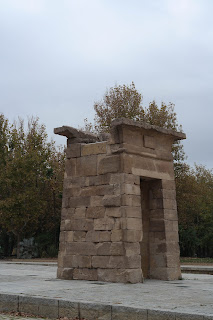Due to having travel credits that were about to expire earlier this month, I took an unplanned vacation to Spain with the caveat that I was not allowed to bring anything other than carry-on luggage.
I didn't have much time to plan an itinerary, but while in Madrid, I wanted to see the Egyptian temple that was given as a "grant-in-return" to Spain in 1968, for participating in the
UNESCO campaign to save ancient sites and monuments at Abu Simbel, which were in danger of being submerged by the Nile due to the construction of the Aswan High Dam.
The Temple of Debod was originally a small shrine dedicated to Amun, dating back to the early 2nd century BCE. It was built south of Aswan, near the
first cataract by order of
King Adikhalamani of Meroe. Later, the temple was expanded and rededicated to Isis of Philae during the reigns of the Hellenic pharaohs Ptolemy VI, Ptolemy VIII, and Ptolemy XII. Construction was eventually completed by the Roman emperors Augustus and Tiberius.
 |
| Egypt, 1859–1860 |
The temple was rebuilt in the Parque de Oeste near the Plaza de España, and inaugurated in July 1972. The temple is open to visitors on Tuesday to Sunday. Entry is fee, but you have to queue to go in, because no more than 10 people (from what I was told) are allowed inside at once. You can visit the official tourism site for
the City of Madrid for more information.
 |
| Spain, 2022 |
The reflecting pool was drained while I was there, so there was a security guard assigned to blow a whistle and yell at people who crossed into the temple to take selfies with the pylon gates.
It took about 1½ hours to get in, but you can take a walk around the park if you have someone to hold your place in line. The view from the hilltop at the west end of the temple is spectacular, and allows you to see the Catedral de la Almudena and the Royal Palace of Madrid.
The architecture of the temple was described in
Travels in Nubia by
Johann Ludwig Burckhardt, and also documented by the architect
François Chrétien Gau.
 |
| François Chrétien Gau, 1819 |
The interior of the temple is dimly lit, and the hieroglyphics decorating the walls of the cella are described by backlit panels supported by metal poles.
 |
| Adikhalamani offers bread to Isis |
 |
Adikhalamani offers a jar of water to the
Pharaoh of Biga and the goddess Anukis (left),
Adikhalamani offers bread to Amun (right) |
 |
| Adikhalamani offers a necklace to Osiris and Isis |
 |
Adikhalamani offers incense and libations
to Osiris and Isis |
 |
| Adikhalamani offers an amulet to Horus and Hathor |
 |
| Adikhalamani offers cups of wine to Amun and Mut |
 |
| Adikhalamani worshipping Arensnuphis and Tefnut |
 |
| François Chrétien Gau, 1819 |
 |
| Shrine of Ptolemy VIII in the adytum |
Narrow stairways lead to the second floor of the structure, where various models and artifacts are on display.
 |
| Temples along the Nile at Abu Simbel |
Of particular interest to me was a 1/50 scale model of the temple in its original state.




















































Thank you very much for this excellent post! I've also visited this small temple in Madrid 10 years ago, but I knew very little about it. Thanks to you, this gap is completed :)
ReplyDeleteHi Phil,
ReplyDeleteThanks for reading, and glad the post was able to provide some info on this interesting temple. I actually didn't know much about the temple before I visited either. I'm now actually kind of interested in seeing the four other temples outside of Egypt in New York, Turin, Berlin, and Leiden as well.
Nice trips to come :) Thank you again.
ReplyDeleteThank you for this post! I appreciate the photos and the commentary very much! I was in Madrid and had planned to see this site, but we didn't make it there. I especially find the scale model pictures fascinating. Thanks!
ReplyDeleteHope you had a good time in Spain Anon. Did you get to see the Museo Nacional del Prado? I went three or four times during my trip to see all the exhibits they had.
Delete